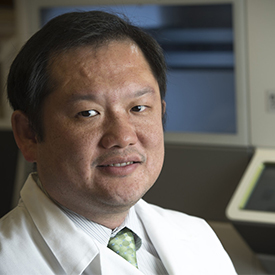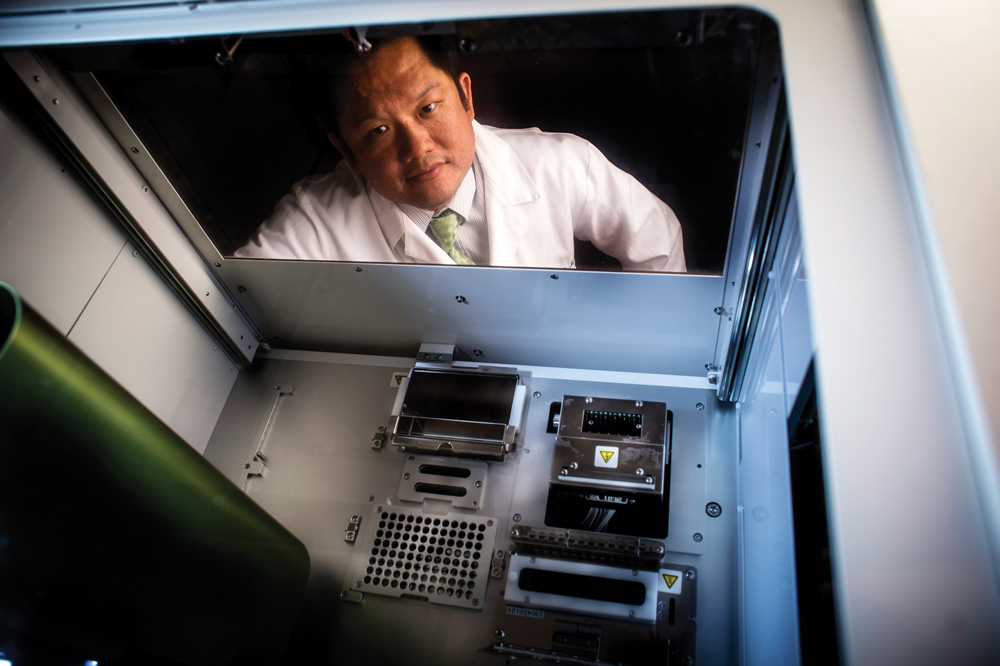 Eddy Yang is the UAB leader for the Strata Oncology Trial, which provides no-cost tumor sequencing and clinical trial matching for advanced cancer patients. Under the microscope, samples from two different patients’ pancreatic tumors may look similar—clumps of abnormally shaped cancer cells and empty spaces where healthy cells have died. But months after a pathologist has peered at these cells and diagnosed cancer, one patient’s tumor may have shrunk in response to treatment, while the other’s continues to grow after undergoing the same treatment. What accounts for the difference? Most likely, each tumor is fueled by different genetic mutations or tweaks to the DNA inside each cell.
Eddy Yang is the UAB leader for the Strata Oncology Trial, which provides no-cost tumor sequencing and clinical trial matching for advanced cancer patients. Under the microscope, samples from two different patients’ pancreatic tumors may look similar—clumps of abnormally shaped cancer cells and empty spaces where healthy cells have died. But months after a pathologist has peered at these cells and diagnosed cancer, one patient’s tumor may have shrunk in response to treatment, while the other’s continues to grow after undergoing the same treatment. What accounts for the difference? Most likely, each tumor is fueled by different genetic mutations or tweaks to the DNA inside each cell.
For the past few years, UAB has offered a select subset of advanced cancer patients the option to gene sequence their tumor, with the hope that it will give clinicians insight into how to treat it. Now, the UAB Comprehensive Cancer Center is one of the first two institutions to partner with Michigan-based Strata Oncology on a trial that makes this service accessible to even more patients. As part of the Strata Oncology Trial, Strata will provide no-cost tumor sequencing to cancer patients at UAB who have tumors that can’t be removed surgically or have spread to another part of the body. It is also available to all glioblastoma and pancreatic cancer patients, although any tumor type is eligible, and the trial includes clinical trial matching.
“This effort allows patients to find more treatment options, because they can potentially go on clinical trials based on genetic markers the sequencing may reveal,” says Eddy Yang, M.D., Ph.D., ROAR Southeast Cancer Foundation Endowed Chair in Radiation Oncology and vice chairman for translational science in the Department of Radiation Oncology. “We will look for key mutations or changes in copy number of cancer genes, and based on that, match the patient to the best possible clinical trial, or most innovative therapy available.”
“Insurance doesn’t traditionally cover next-generation sequencing, which costs $3,000 to $4,000 per test, so it has been fairly prohibitive for the public to pay for it out of pocket,” says Edward Partridge, M.D., the Evalina B. Spencer Chair in Oncology and retiring director of the UAB Comprehensive Cancer Center. Now, he points out, cost will no longer be an issue for patients who qualify for the Strata Trial. Strata plans to sequence 100,000 patients across the country in the next three years.
Precision Targeting
The idea behind all precision medicine is to take individual variation—genetic, environmental, and lifestyle—into account when treating disease. When it comes to cancer, precision medicine most often means diagnosing and treating a tumor based on its genetic profile rather than its location in the body or appearance.
Before the Strata Trial launched at UAB this February, Yang helped establish UAB’s Molecular Tumor Board (MTB) in 2013. This group of physicians and geneticists, which was pilot funded by UAB Hospital and Blue Cross and Blue Shield of Alabama, reviews cases of patients whose advanced cancer has failed to respond to treatment, and the group decides whether to sequence the tumors. The MTB also interprets the gene sequencing results and determines the proper course of action. While the Strata Trial has made gene sequencing available to more cancer patients, the MTB remains integral to UAB’s cancer precision medicine efforts, Yang says. “We continue to meet monthly, and we use the MTB to discuss Strata results and recommend treatment for patients if something is found through sequencing,” he notes.
 Eddy Yang with the nCounter Analysis System, which allows researchers to measure the expression of genes in a targeted manner.One of the first patients whose tumor was sequenced at UAB was a patient with salivary gland cancer. “The patient really had no treatment options left,” says Yang. But DNA sequencing revealed that the tumor had a mutation more often seen in melanoma, a form of skin cancer. Therefore, Yang and his colleagues recommended treatment with the melanoma regimen. “The cancer responded pretty well,” says Yang. “The patient was in remission for more than a year.”
Eddy Yang with the nCounter Analysis System, which allows researchers to measure the expression of genes in a targeted manner.One of the first patients whose tumor was sequenced at UAB was a patient with salivary gland cancer. “The patient really had no treatment options left,” says Yang. But DNA sequencing revealed that the tumor had a mutation more often seen in melanoma, a form of skin cancer. Therefore, Yang and his colleagues recommended treatment with the melanoma regimen. “The cancer responded pretty well,” says Yang. “The patient was in remission for more than a year.”
That kind of anecdote is the ultimate cancer treatment success story from a precision medicine perspective. But, sadly, it’s not always the outcome. “Sequencing isn’t a magical cure at this point; we’re not going to find drugs for every person whose tumor we sequence,” says Yang. “But we may be able to offer better treatment options for some patients.”
In some instances, the goal is simply to give a patient enough time to allow existing drug development efforts to advance. “Because of the furious drug development that’s occurring, sometimes what we’re trying to do is buy patients enough time to get to the next treatment,” Yang says. “We have patients for whom we found an actionable mutation that we treated before immunotherapies were approved, and we were able to bridge them to the point where immunotherapy became approved. So it’s this idea that, can we buy our patients enough time for another drug to get approved?”
Fueling Discovery
The idea behind precision cancer treatment sounds straightforward: Sequence a tumor’s DNA, or measure levels of another molecule of interest, and treat the cancer based on those results. But it’s not as easy as it sounds. Over time, the genetic mutations in a tumor can change. Different cancer cells within the same person can have different genetic mutations, and multiple mutations can work together to influence a tumor’s behavior.
Much more research is needed to determine when genetically sequencing a tumor proves most worthwhile and how to follow a tumor’s progression and adapt treatment plans accordingly. Some scientists are studying how to isolate cells from patients’ blood that have sloughed off a tumor and are circulating through the body. Others are trying to discover new gene mutations associated with cancers or develop drugs that reverse the effects of those mutations.
All precision medicine research projects have one need in common: large amounts of patient data. By looking at the DNA of tens of thousands of patients, researchers can make new connections between the genes—or proteins—of patients and the drugs they respond to. They can also see how patients’ cancers progress. Ultimately, the Strata Trial plans to sequence tumors for 100,000 advanced cancer patients across all its network sites.
Enhancing Knowledge
The new collaboration between UAB and Strata aims not only to guide patients through their individual sequencing results, but also to help propel research. Physician-scientists will use genetic tumor data gathered as part of the Strata Trial for future research projects. “Strata will be reporting genetic abnormalities to us that are significant for how we treat patients,” says Partridge. “But we’re also looking at genes beyond those.”
If UAB can collaborate with other institutions across the country and world, researchers everywhere will benefit from the sequencing of patients at UAB. “We serve an ethnically diverse population, and research in a lot of other places often doesn’t capture that diversity,” says Yang. When it comes to precision medicine, diversity is critical. By studying genes or cancer progressions in only one uniform population, results are skewed and cannot be applied to a broader population.
Not every cancer patient at UAB will currently qualify for genetic sequencing, and not every patient whose tumor is sequenced will find a new, winning treatment strategy to send him or her into remission. However, precision medicine is a rapidly developing field. Projects like the Strata Trial are pushing it forward and trying to help as many people as possible, says Partridge.
“We’re in the infancy of drug development for precision medicine in cancer, but new genes are being discovered every day, and new drugs are being developed to target those genetic abnormalities,” Partridge says. “I think it’s really only a matter of time before we treat all cancers based on their genomic abnormalities rather than where they originated or what they look like under the microscope.”
By Sarah C. P. Williams